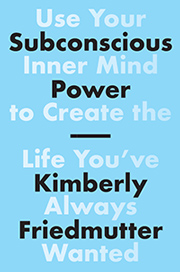Mind Over Body: How to Rewire Your Subconscious Mind for Greater Health and Wellbeing
BY KIMBERLY FRIEDMUTTER
 photo: analise benevides
photo: analise benevides
Many of my clients reach out to me for help with physical complaints. No, I am not a doctor, nor do I diagnose symptoms. But I do believe that on some level, the women and men who seek me out understand that their symptoms—aches and pains, trouble sleeping, depression, infertility, anxiety, weight issues, stomach upset, blood pressure, and addiction or substance abuse—can find some relief through hypnosis. And they are right. These are women and men of all ages, backgrounds, and awareness levels, and many come to me as a kind of last resort—they’ve been to doctors, psychologists, acupuncturists, ministers, or shamans who have offered protocols of all persuasions. But their problems are stubborn, deeply rooted, and often leave them feeling hopeless.
Through our focused work on the subconscious and the power of the mind over the body, my clients discover a new way to think about wellness, their bodies, and their physical ailments. I listen, observe, and then guide them to connect with their inner selves to get to the root of their problem and how they unwittingly may have helped create it. Yes, created. We like to acknowledge all the good things that we create for ourselves but feel uncomfortable about and resistant to admitting to the problems we create for ourselves. There is something incredibly empowering about recognizing the role you play in your health—once you take ownership of having created the problem, you can then take proactive steps to fix it!
You’re probably wondering how a physical issue or ailment can be created and what the connection is to the subconscious. I suppose you already heard the “mind over body” phrase many times over. But, what does that mean? Through my work, I’ve come to understand that physical issues can be caused by past or present heartache. Debilitating anxiety can be the aftereffect of trauma or emotional shock to your overall body-brain system. Frustrated and hopeless, most people don’t know about this mind-body connection. It gives me great satisfaction when clients come to me and through our work together, and oftentimes with their physician’s assistance, they are able to return to excellent health.
What sort of results have I seen? Claire came to see me after almost a year of struggling through menopause symptoms that nothing seemed to alleviate. She used hypnosis to tune into her body and determine if her symptoms were something she might be able to calm down on her own. Once she stopped resisting the hot flashes, moodiness, and trouble sleeping, the symptoms began to settle down. For Claire, her resistance was stoking her hormonal imbalances. The concept of mind over body control helped her ease the pain caused by the menopause symptoms.
Todd, a client who was being treated for mesothelioma (an aggressive form of lung cancer), came to me after treatment; half the cancerous lung had been cleared by the necessary medical interventions, and his doctors were pleased with the results. Todd wasn’t. He wanted to see if he could find a way to communicate with his damaged lung. This is when he sought me out. Through hypnosis and deeper work with his subconscious, he was able to feel optimistic, connect to his immune system, and lower his stress. After a month of practicing these Hypnotic Hacks, Todd returned to his oncologist, who was amazed at his improvements. The subconscious can seem almost magical at times.
These reactions to stress and illness can bring relief. However, you do not have to be ill or have a specific disease to benefit from the Six Principles and Hypnotic Hacks I’ve outlined in my book. Indeed, my work with people teaches them how to use the concept of mind over body healing and their subconscious to improve their health in general, not to address a specific ailment. I think of our bodies as vessels for all that we are—body, mind, and soul—and they need protection and good care. And when we use our subconscious power to tap into our bodies and its signals, truly listening to what our bodies are telling us, then we are better able to be their stewards and reach or maintain optimal health and wellness.
When Your Ailment Is Working for You
I’ve seen many clients develop a dependence on their own illness because it “works” for them on an obscure level. This may sound counterintuitive—how can someone’s illness work for them?—but think about it for a moment. If someone feels alone or misses a cherished parent, having caring women and men in white lab coats dote on them may fill a void. But what kind of life is that? I guide clients through their dependency by helping them envision their own health and imagine a life of well-being where they become truly accountable. I show them how their illness has come to define them so they can move past it.
This was the case with Robert, who has suffered from a bad back for years. Before trying the mind body spirit healing, he’d complain constantly about his pain. And yet in his regular diatribe, I picked up on a certain note of pride, as he implied that his enduring the physical suffering was an accomplishment.
He described his weekly routine in such a way that it became clear that he was attached to his suffering. For example, he told me that his favorite day of the week was Saturday. When I asked him why, he explained that it was the day he had physical therapy for his back. He described that on his way to PT, he’d fit in time to eat his favorite yogurt, then stop for a latte, and then a quick game of mah-jongg in the park. When he got to the PT office, he said, he loved having a quick flirt with the receptionists, enjoying every moment. He described those details with a big smile on his face.
What’s Wrong with this Picture?
Robert’s bad back was working for him. He was holding on to this ailment because he’d made it bring him happiness—in the form of lattes, mah-jongg, and frozen treats. He created a day of socializing around his ailment, and that day had become the cornerstone of his weekend. What intrinsic motivation did he have to get better and give up his bad back? On a subconscious level, his bad back isn’t bad at all.
In other words, Robert had grown dependent on a physical ailment because it gave him permission to enjoy himself. Through our work together, he was able to clarify the discrepancy between the actual discomfort he experiences in his back and his need for more pleasure. When he was able to be more truthful about his desire for enjoyment and how he mistakenly believed that his back pain prevented him from these pleasures, he was able to use the mind over the body technique to take some concrete steps to shift his relationship with his bad back. First, he gave himself rewards throughout the week, not reserving them only for Saturdays. Then he took more accountability for the root causes (the tightness in his hips and his weak core muscles, for starters) of the chronic pain he was experiencing. With these two simple actions, Robert was able to give himself permission to really go after pleasure in his life and to take care of his body in a more complete, conscious way.
Let me share another story about the power of the mind over the body. This one is about my client Will, the meat-eater. Will loves backyard BBQs, so much so that he even named his grill: he calls her Sue. Will also likes fitness, so it made sense that he would fall in love with Rebecca, his yoga instructor, whom he says looks great in her down dog and who is a vegetarian health fanatic.
The two fell madly in love and were soon engaged. Because of his devotion to Rebecca, he follows her lead when she introduces a new health fad—cleanses, boot camps, liquid diets, intermittent fasting—you name it, they tried it. Before the wedding, Rebecca asked Will to go meat-free, and as a sign of his love and good intentions, he agreed. This was not no sex before the wedding day; this was no meat before the wedding day.
Veggies ruled for a while—veggie broccoli steak, veggie jerky, veggie chili. You get the idea. But soon, Will started to not feel well. He’d feel fine all day at work, but as soon as he came home, he’d start to feel sick to his stomach and achy, and would need to go to bed. Rebecca assumed it was his body making the transition from a body built on meat to a healthier body fueled by greens.
But what was really making Will so sick? There was one thing he did not tell Rebecca: he’d been secretly eating meat all along at lunch during the workday. It wasn’t really the meat that mattered.
It was that meat mattered to Will. Unwittingly, Rebecca had asked Will to give up a very basic but important need in his life, and Will could not really give it up without feeling deeply resentful. But the toll of lying to Rebecca was more powerful than the resentment: it was making him physically sick.Until Will came into accountability and confessed to Rebecca that he had continued to eat meat, he would continue to feel sick. He was conflicted because he loved both Rebecca and (his grill) Sue. But secrets don’t bond us; they shred us.
Will and Rebecca eventually discovered a happy compromise, which allowed Will to eat meat but also participate in Rebecca’s meals, eating and enjoying lots of veggies! They both benefited from being more honest about their needs and learned how to create a more mutual give-to-get principle in their relationship. A win-win!
Hypnotic Hack: Be Body Aware
What role are you playing in your illness? You must be willing to explore the emotional ties to your pain or ailments. Be honest when you look at yourself and how certain choices and patterns keep you locked in physical discomfort. Tapping into your subconscious enables you to release physical dependencies that may parade as illnesses. This exercise will enable you to bring into clarity what is physical… and what might have unacknowledged or unresolved emotional roots.
1. Close your eyes and go within.
2. Imagine your health.
3. What physical issues or limitations are you experiencing?
4. What secondary benefits are you experiencing by holding on to this condition? (This step requires accountability. We don’t want to believe that we are playing a role in limiting ourselves this way; remember, this information isn’t coming from your conscious mind, but from your subconscious. You may be unwittingly causing yourself to feel discomfort as a means of self-protection or self-limitation. Does this ailment keep you from working at a job you don’t enjoy anyway? Are you afraid of failure? Maybe this distress gives you the attention you crave from an otherwise distant family member or mate. Are you restricted from enjoyable activities? What is at the core of not being able to hike with your family?)
5. Imagine all the things you would do successfully if this condition or situation were not in your life. In what ways would this new freedom allow you to enjoy your life, spend more time with your loved ones, reach new career heights?
There is a very powerful fact: the decision is yours. Physical conditions can arise from continually ignoring what’s really going on. When you tap into your subconscious and really attune yourself to a level of mind-body control, you will know what’s real and what’s not. Yes, you’ll have to be brave. Yes, you may need to remind yourself that you are capable and supported. Have faith that you are indeed ready—it’s time to elevate your health.
On Louise Hay’s Symptom List
In many ways, Louise Hay was the first to identify and define how our minds are connected to our bodies. In her well-recognized Symptom List, which I have adapted here, Hay points to how certain areas of the body and specific symptoms may be related to emotional states or feelings. Consider this list as you begin to tune into your own body and learn the power of the mind over the body.
Acne: Not accepting the self. Dislike of the self.
Addictions: Running from the self. Fear. Not knowing how to love the self.
Allergies: Denying your own power.
Alzheimer’s Disease: Refusal to deal with the world as it is. Hopelessness and helplessness. Anger.
Ankle: Inflexibility and guilt. Ankles represent the ability to receive pleasure.
Anxiety: Not trusting the flow and the process of life.
Arthritis: Feeling unloved. Criticism, resentment.
Back Issues: Represents the support of life.
Lower Back Pain: Fear of money or lack of financial support.
Mid-Back Pain: Guilt. Stuck in all that stuff back there. “Get off my back!”
Upper Back Pain: Lack of emotional support. Feeling unloved. Holding back love.
Broken Bones: Rebelling against authority.
Cancer: Deep hurt. Long-standing resentment. Deep secret or grief eating away at the self. Carrying hatreds.
Cholesterol: Clogging the channels of joy. Fear of accepting joy.
Constipation: Incomplete releasing. Holding on to garbage of the past. Guilt over the past. Sometimes stinginess.
Depression: Anger you feel you do not have a right to have. Hopelessness.
Diabetes: Longing for what might have been. A great need to control. Deep sorrow. No sweetness left.
Eczema: Breathtaking antagonism. Mental eruption.
Fatigue: Resistance, boredom. Lack of love for what one does.
Foot Problems: Fear of the future and of not stepping forward in life.
Hands: Hold and handle. Clutch and grip. Grasping and letting go. Caressing. Pinching. All ways of dealing with experiences.
Headaches: Invalidating the self. Self-criticism. Fear.
Heart Attack: Squeezing all the joy out of the heart in favor of money or position. Feeling alone and scared. “I’m not good enough. I don’t do enough. I’ll never make it.”
Heart Problems: Long-standing emotional problems. Lack of joy. Hardening of the heart. Belief in strain and stress.
Hip: Fear of going forward in major decisions. Nothing to move forward to.
Impotence: Sexual pressure, tension, guilt. Social beliefs. Spite against a previous mate. Fear of mother.
Indigestion: Gut-level fear, dread, anxiety. Griping and grunting.
Inflammation: Fear. Seeing red. Inflamed thinking. Anger and frustration about conditions you are looking at in your life.
Insomnia: Fear. Not trusting the process of life. Guilt.
Kidney Stones: Lumps of undissolved anger.
Knee: Represents pride and ego. Stubborn ego and pride. Inability to bend. Fear. Inflexibility. Won’t give in.
Legs: Carry us forward in life.
Menopause Problems: Fear of no longer being wanted. Fear of aging. Self-rejection. Not feeling good enough.
Neck: Represents flexibility. The ability to see what’s back there. Refusing to see other sides of a question. Stubbornness, inflexibility. Unbending stubbornness.
Osteoporosis: Feeling there is no support left in life. Mental pressures and tightness. Muscles can’t stretch. Loss of mental mobility.
Pain: Guilt. Guilt always seeks punishment and it can cause chronic pain.
Sinus Problems: Irritation toward one person, someone close.
Sprains: Anger and resistance. Not wanting to move in a certain direction in life.
Stiffness: Rigid, stiff thinking.
Throat (sore): Holding in angry words. Feeling unable to express the self.
Thyroid Gland: Humiliation. “I never get to do what I want to do. When is it going to be my turn?”
Hyperthyroid: Rage at being left out.
Varicose Veins: Standing in a situation you hate. Discouragement. Feeling overworked and overburdened.
Weight Issues: Often represents fear and shows a need for protection. Running away from feelings. Insecurity, self-rejection, and seeking fulfillment.
Wrist: Represents movement and ease.
Where Are You Now?
Take a moment to think about your own body and respond to the questions below:
1. Do you often wake up feeling rested after a night’s sleep?
2. Do you have the energy for the activities you enjoy?
3. Can you walk up a flight of stairs with ease?
4. Are you able to touch your knees (or maybe your toes!)?
5. Can you raise your arms overhead?
6. Are you able to balance on one leg for any length of time?
7. Do you often find yourself hungry or craving certain foods?
8. Do you go to sleep around the same time each night and stay asleep?
9. Do you enjoy spending active time outdoors?
10. Do you belong to a gym?
If you responded “yes” to most of these questions, then you are more than likely taking good care of your physical health. If you answered “no” to more than three questions, then pay particular attention to the lessons in this article.
The Truth Behind Surprising Diagnoses
When you are connected to your subconscious, you are in tune with your body at a cellular level. You are in tune with its ups and downs, its ebbs and flows. You know that the reason you have a headache is that you are dehydrated after a long walk or run. You know that you woke up feeling sluggish because you had one too many glasses of wine, an unhealthy meal, or a too-big dessert the night before. You know that your stress level is a bit higher than usual because you’ve recently moved offices or homes. In other words, you have the ability to listen to your body and read its cues, which in turn positions you to respond immediately to alleviate the symptom or address the cause. You drink plenty of fluids to reverse dehydration. You rest, avoid sugary foods and beverages and do a mini cleanse to cleanse your liver and blood to get rid of that hungover feeling. Whatever the issue, you address it, so it doesn’t have a chance to worsen.
The opposite happens when you’re out of sync with your subconscious; it’s as if warnings come out of the blue, but do you pay attention? Here is an example from my own life. During a time of enormous stress, when my elderly father was going through some health issues, he turned to me from his hospital bed and said, “Kimberly, what is that bulging bump on your forehead?” I couldn’t feel anything, and I figured it was his bad eyesight or a shadow from poor lighting. When I eventually looked in the mirror, sure enough, I saw a big, distended, blue-and-purple vein on my temple. I sent a picture of it to my doctor.
“Be very careful,” my doctor told me, “because it’s in a precarious position.”
“What is it?” I asked in frustration.
“It’s probably stress,” responded the doctor blithely. I listened. “You’re under a lot of stress right now, Kimberly, isn’t that so?”
“Yes,” I replied.
“And you’ve been traveling back and forth from Nevada to California to Texas, correct?”
“Yes.”
“These kinds of things can appear during stressful times, so I recommend you take a deep breath, sit and relax, and check on it then.”
I followed my doctor’s advice, and in thirty minutes the bulging vein was gone. I am not worried about it returning because it doesn’t have to—I’m now connected to my subconscious and keeping my stress levels in check. Thanks to the literal heads-up, which served as a reminder of the power of the mind over the body.
The surprise is not the actual diagnosis; the surprise is that we are unaware of our bodies and changes to them. When we use our subconscious power to stay tuned in to our bodies, its shifts, and changes, then it’s easier to keep our health in alignment.
However, when your subconscious and your conscious mind are out of balance, you will not look or feel your best. Some people will overextend themselves. Others will stop eating right or eat too much of foods that don’t make them feel well. Still, others will begin to sleep poorly, and the signs of fatigue will show—around the eyes, for instance. Interestingly, friends and loved ones who are in tune with their subconscious will notice this about you right away. Hence their well-meaning comments of “You look tired” or “Are you feeling okay? You don’t seem yourself.” Since the subconscious is a primal, instinctual kind of knowing that we all share, connecting us at the pack level, we can sense when others in the pack are not at their most fit.
If we are disconnected from our subconscious, it will communicate to us in a different way: our bodies will reflect key messages from the subconscious. When we ignore our bodies and these messages, ailments will crop up and surprise us. This is the subconscious demanding to be heard. When we really suppress our subconscious, we can trigger the disease.
In the paragraphs ahead, you will learn a lot more about how your body reflects the yearnings of your subconscious. Heed its warnings. Take good care of it. Your physical body and health are an important barometer of the connection between your subconscious and your conscious mind.
Know Your Body
Living our lives necessitates continual healing at a cellular level. Our bodies are always responding and adapting to outside negative influences—environmental stress, pollution, viruses, and a host of microscopic organisms that can negatively affect our bodies and brains. The key to maintaining your subconscious power and using it to protect your health and build your resistance from outside threats is to tap into your body in a regular way. Use the Body Scan hack below as a way to do so.
Hypnotic Hack: Body Scan
To get a better sense of how your physical ailments may be connected to a non-physical source, try the following exercise and experience the miracles of mind over body healing:
Consciously notice and write down different body parts that you feel are malfunctioning now or that you may worry about in the future. Notice the function for each body part and refer to the symptom list on the previous pages. For example, if your hands hurt, what are you having trouble grasping? If your hips hurt, you might be in need of balance. The knees represent your pride and ego. Learn to cue into the emotional roots to physical symptoms. Our body parts correspond and react to our thoughts, and if these thoughts are unattended, the physical problem persists until it awakens our attention.
In this exercise, you will be asking your subconscious to reveal to you any physical issues and concerns that need to be brought to your conscious attention. It’s not unusual for this exercise to reveal more than one issue, so have a piece of paper and a pen or pencil handy so that you can make a list.
A body scan is a tried-and-true exercise recommended by many practitioners as a way to bring attention to the sensations of your body and train yourself to attend to its needs. I’ve adapted this body scan based on what has worked best for my clients and myself. It’s a great way to connect your subconscious to the areas of your body that might be out of balance and need some attention, care, and mind, body and spirit healing.
I love this protocol in conjunction with regular doctor visits because oftentimes your physician will ask you to identify your aches, pains, symptoms, or reason for your visit. When you relay this information to your medical professional, he or she is in a better position to identify the issues, answer your questions, and respond to your concerns. Remember, a surprise diagnosis can be a diminished link between the subconscious, the conscious mind, and the body.
1. Close your eyes and go within.
2. While relaxed, breathe deeply in and out.
3. With each breath, imagine various parts of your body. Begin at the top of your head, moving to your neck, down your spine, into each of your limbs, and ending at your feet.
4. Notice the sensations you encounter and where on your body these sensations occur. (Do you encounter any stiffness? Blockage? Tightness?)
5. If yes, breathe into the affected body part. Feel the rhythm of your breath, massaging any discomfort until that body part feels released.
6. Ask your subconscious to identify the original source of that discomfort. (Oftentimes the name of a person, place, or thing will come into your awareness.) Continue to breathe into the resolution, releasing any residual discomfort.
7. With each new body part, repeat this breathing technique until all symptoms subside.
8. While continuing to breathe deeply, send gratitude to your subconscious for your new awareness and connectivity to your physical body.
Welcome your discoveries, knowing you can check on your body any time you choose. And remember, physical discomfort is meant to get your attention; you can admit nothing gets our attention like discomfort. It’s actually your ally, your guide. Use it for what it is: an alarm. This is where the subconscious comes in. In other words, when emotions on the inside are out of step with ecology on the outside, there can be a physical imbalance.
The Importance of Fitness
Your health emerges from the inside out. Getting fit through eating a clean, balanced diet and exercising regularly is not about vanity. It’s about building a body that is reliable and resourceful. You know that feeling when you are so tired, your lack of energy keeps you from doing what you want? Respecting your body makes it reliable. Treating your body like the vessel also shows your SoulSpirit that you care; this care is a form of respect toward your SoulSpirit and one of the primary keys to healing mind, body and soul.
When I think about health and fitness, I like to envision an airplane pilot seeking balance, keeping both wings parallel to the horizon to level the plane. When the plane lists to one side or a malfunction is detected, lights flash, sirens whine, and occasionally a mechanical voice will repeat a warning to get the pilot’s attention. Imagine that the plane is your body and the whirring instrumentation is your subconscious.
A 2007 study done by Cornell University professors revealed a surprising statistic: the biggest weight loss or the most weight dropped by women is before their weddings. How do the brides themselves explain the weight loss? Because they want to like how they look in their wedding photos. But the study findings disagree, and instead suggest that the primal directive from the subconscious was suggesting women lose weight so their grooms would believe they had made the best choice in a mate. The research seems to suggest that on a subconscious level we want to be perceived as fit.
In fact, with clients who struggle with their fitness, I found a direct relationship between the amount of unhappiness they experience and the amount of slack they have allowed themselves: the more they cared, the more fit they were; the more slack they gave themselves, the less fit they were… and the less happy. The slack they afforded themselves and the level of unhappiness were in direct proportion to each other. In other words, the more they let their health slide and recognized it, the more unhappiness they experienced.
Weight fluctuation is not uncommon during the course of a lifetime, and there are many reasons people put on extra pounds here and there—divorce, stress, sickness, hormone changes, job loss, job gain… the list is endless and ever-changing. We are all susceptible to weight and fitness fluctuations during stressful times. The key is to then right our course. Becoming fit should never involve an endless binge-and-purge cycle. It does not require deprivation or scarcity.
Now, at the risk of raising a touchy subject, I want to address the real pain of weight issues: they can be an outward sign that something is unbalanced on the inside. Our bodies are designed to always seek homeostasis, a place of equilibrium for all our physiological processes. Homeostasis is the basis for an interesting and sometimes controversial approach to thinking about stubborn weight issues: set point. First identified in 1982 by nutrition scientists William Bennett and Joel Gurin, set point theory states that a person’s body has a predetermined weight range in which it feels most comfortable, which implies that your body will sabotage itself during weight loss by slowing down your metabolism and the rate at which it burns or consumes calories. Regulated by the hypothalamus, this set point also suggests that the internal regulating system of overweight or obese people has become disrupted due to overeating, sedentary lifestyle, and other factors. Of course, set point theory also explains why it’s so difficult for people to lose weight and keep it off for good. All our bodies are looking to return to their set point.
People who are either not tapped into their subconscious or whose subconscious and conscious mind are out of sync will tend to not eat enough or to eat past satiety, consuming more food than their bodies can utilize. Due to the mind-body connection, our subconscious is preprogrammed to do everything it can to get the body what it needs; sometimes, the conscious mind resists this information.
Some people, of course, go in the other direction toward fitness and push themselves to an extreme. Sometimes to such an extreme that an injury, stress attack, or exhaustion might occur. Fanaticism in either direction is going to hurt your equilibrium.
True health is the result of first understanding your real thoughts and real reasons for eating and exercising like you do. Do you move away from what’s best for you? Do you hang out with other family or friends where eating unhealthily has become your routine and your bond, an excuse not to thrive? Are you in a misery-loves-company relationship with Ben & Jerry’s?
Once you explore these questions and tune into your subconscious, you may be surprised at what you may find. At the end of the day, your actual, personal set point is irrelevant; what matters is that you find the real you, the healthiest version of you, whatever size or fitness level that’s intended to be. Only a misdirected subconscious is more comfortable in an unhealthy body. The good news for us is that our subconscious power can alter our set point and guide the body into creating a new normal, a new baseline or range of healthy weight.
With the power of the mind over body, you can not only envision yourself in a new way but also create life-sustaining habits that support sustenance and satiety. You may not consciously know or believe that you can achieve a healthy, fit body with little effort. More important, you can maintain a healthy, balanced physique, because ease equals balance. Dis-ease equals imbalance. Did you ever try to guide a wobbly grocery cart through the store, continually fighting the off-balance wheels? The cart lists to the side and pulls off course, requiring strenuous effort just to roll to the next aisle? The same holds true for a body out of alignment. The fight, the tug, the pull is exhausting and requires such effort just to roll straight ahead. You know the feeling.
The Pillars of Self-Care
Your body is a vessel for producing and using energy. It works more efficiently and functions more optimally when it is nourished with clean foods, well-hydrated, given exercise, and refueled with adequate rest. These pillars of self-care are not new concepts, but they are essential for physical health; they are necessary for using your subconscious to the best of its abilities. Self-care is a major part of playing big in your life. Why? Because playing big insists that you put yourself first and care for your body. Your body and brain are living biochemical organisms that require upkeep, fuel, and lots of TLC. Taking good care of your health is also vital to being able to live an expansive life. Sleep, clean food, and regular movement refresh the connection between your subconscious and your conscious mind.
Remember, the universe will give you more than you can imagine. But to access those oversized goals, you need to be ready to embrace what that means physically—you need to be prepared to perform at a top physical level. This starts with self-care.
Sleep Well
Your day begins with a good night’s sleep. If we don’t sleep well, we don’t think well. Poor sleep leaves us vulnerable to a host of diseases. It means we cannot be as productive during daylight hours. Think of sleep as the time when your body’s mechanics rush in to repair the damage of the day, whatever that is; healing the immune system, cellular repair, neurogenesis, memory consolidation, and more all take place when the body is at rest. Giving your body the necessary care so that it can repair itself is critical for both your short- and long-term health. And your subconscious is also very busy during sleep; this is the late shift for your body’s working mechanisms.
What if you’re struggling with disrupted sleep? Remember how the subconscious wakes you up at 3:00 or 4:00 a.m. if you have unfinished business? If you’re not sleeping well, keep a pen and paper next to your bed. If you find yourself awake, write down whatever comes to mind. Alternatively, if you are having trouble falling asleep, jot down the questions, doubts, and worries that are keeping you up—oftentimes upon waking, you’ll find that your subconscious has figured out solutions.
Eat Well
While I do not subscribe to any one style or approach to eating, I recommend to my clients that they eat as clean as possible as part of the mind over body healing process. Think of your body like a high-performance car. You would give that car optimum fuel for optimum performance, and clean fuel works best. What does it meant to “eat clean”? Clean foods are foods that occur in nature and are not altered, including:
+ Fresh, locally grown or organic vegetables and legumes
+ Fresh, locally grown or organic low-sugar fruit (berries)
+ Grass-fed meats
+ Wild-caught fish and seafood
+ Ancient grains that have not been processed
+ Minimal dairy
Eating clean also means consuming as little sugar as possible and staying away from packaged, processed foods. Think whole, baked sweet potatoes rather than potato chips. Or a leafy kale salad over a processed energy bar. Eat lean protein in the form of red meat, poultry, and fish. Enjoy organically grown fruits in season so you don’t overindulge (fruits contain sugar!). Always include green vegetables with your meals. Consciously include fibrous foods, such as legumes, brown or wild rice, and seeds and nuts. And drink lots of water. All this will keep your blood sugar balanced, help you maintain a healthy weight, reduce inflammation, and help you alleviate the symptoms of and ward off illness and disease.
A number of clients come to me because they struggle with their weight or feel like they cannot control themselves around food. My secret weapon to help these clients lose weight and get healthy is to ritualize their food intake, which helps build a healthful anchor to your eating habits. Creating a ritual around eating brings awareness and soulfulness to the reverential act of feeding oneself. Here are some simple suggestions for creating a ritual around eating:
+ Set the table before you sit down.
+ Look at the balance of foods on your plate or in your bowl.
+ Give thanks that you have food to enjoy.
+ Eat slowly, savoring the taste and flavor and texture of the food.
When we assign meaning to things, especially the communion of taking in nutrients, we satisfy the subconscious while we feed our body, mind, and soul. Giving reverence to food gives it importance beyond just shoveling food into our mouths and satiating our hunger.
When I want to bring a sacred aspect to the ritual of eating, I create a “one-bowl” experience: an ancient practice of putting an entire meal—veggies, some clean protein, and a grain—in one bowl and then enjoying it slowly using only my fingers to eat (if you prefer, you can use chopsticks). There are several beneficial aspects to this way of eating. The simple dexterity of the chopsticks slows you down, which allows your level of satiety to keep up with your intake. Eating with your fingers is very primal and reinforces the basic connection to that which fuels you. Food and eating are tactile, and bringing awareness to the ritual of eating enlivens all our senses and literally feeds the subconscious. Many trendy restaurants are now serving this form of one-bowl meal because it works. It’s healthy, satisfying, and very close to our nature of collecting.
There are additional benefits to be had from ritualizing your meals while putting the mind over body concept to heart. Infusing any act or event with meaning helps you stay present and provides a fuller experience. Instead of mindlessly eating at your desk while working or checking your social media over dinner, add reverence to the experience. You will enjoy your meal more, and it will be more satisfying—physically and spiritually. Even a small change like this to your daily routine—going from mindless meal to mindful ritual—will enable your subconscious mind to create healthful shifts in your body.
Move Well
Your body needs to be active in order to remain flexible, stave off illness, restore itself, and offset the inevitable stresses of our daily lives. And did you know that aerobic exercise is the only way of growing new neurons (a process known as neurogenesis)? This perfectly represents the mind-body connection. You get to decide on what type of exercise to do, because the bottom line is, whatever you enjoy, you will do! There is truly something for everyone, so go for what suits you and your lifestyle. And by all means, utilize the principles of the subconscious to ramp up your self-care.
1. Be accountable about where you are physically. What is your starting point? Are you physically unfit? Are you somewhat fit, with room for improvement?
2. Your higher self knows the fitness level perfect for your needs. Don’t push yourself to try an intense spin class if that doesn’t feel right. Maybe what you need is a long walk in nature instead. And vice versa.
3. Do you move toward health and fitness or away from fatness and sickness? What is your internal motivator? Remember—it is easier and more powerful to move toward what’s positive than away from the negative.
4. Do you have the support of friends and family to take on a healthier mind-set and routine? Surround yourself with doers not talkers, movers not sitters.
5. You are going to give it your all (energy and commitment) in order to get your all (fitness and optimal health).
6. Your fit and healthy body will be your vehicle for your time here. It will support your work and play, your desired lifestyle. You cannot play big unless your body is ready to play big.
We cannot be our best selves—body, mind, spirit—unless our vessel is strong, supple, energetic, and well-tended.
Taking good care of the bodies we inhabit on this earth is a must. I urge you not to let contrast be your teacher. We all know that we only really notice our good health after sickness. But daily care will keep you in your best performance.
Excerpted with permission from SUBCONSCIOUS POWER: Use Your Inner Mind to Create the Life You’ve Always Wanted by Kimberly Friedmutter, published by Atria Books, a division of Simon & Schuster, Inc. Copyright © 2019 by KBF Entertainment LLC.
About The Author
Kimberly Friedmutter is a world-renowned board-certified hypnotherapist who works with some of Hollywood’s best-known luminaries, titans of industry, and leaders around the globe. Kimberly is a member of the prestigious UCLA Health Systems Board, the American Board of Hypnotherapy, the Association for Integrative Psychology, and the International Hypnosis Federation. She is also a certified neuro-linguistic programming trainer. Learn more at kimberlyfriedmutter.com
























